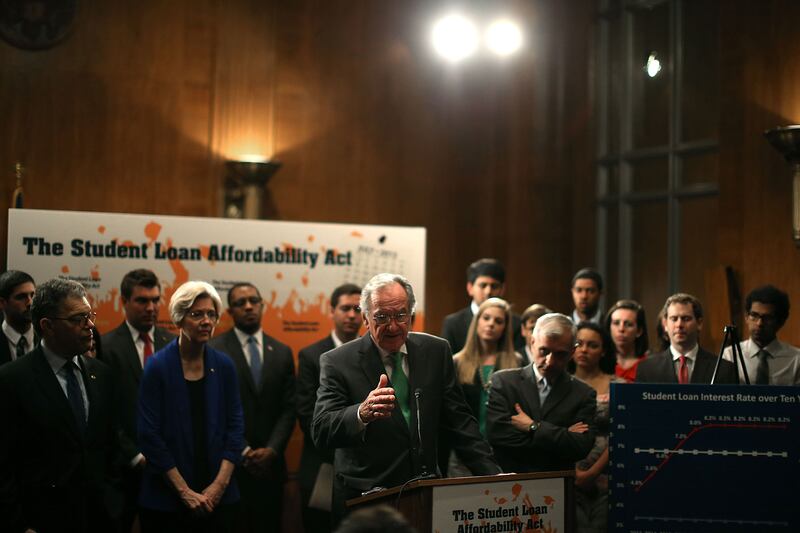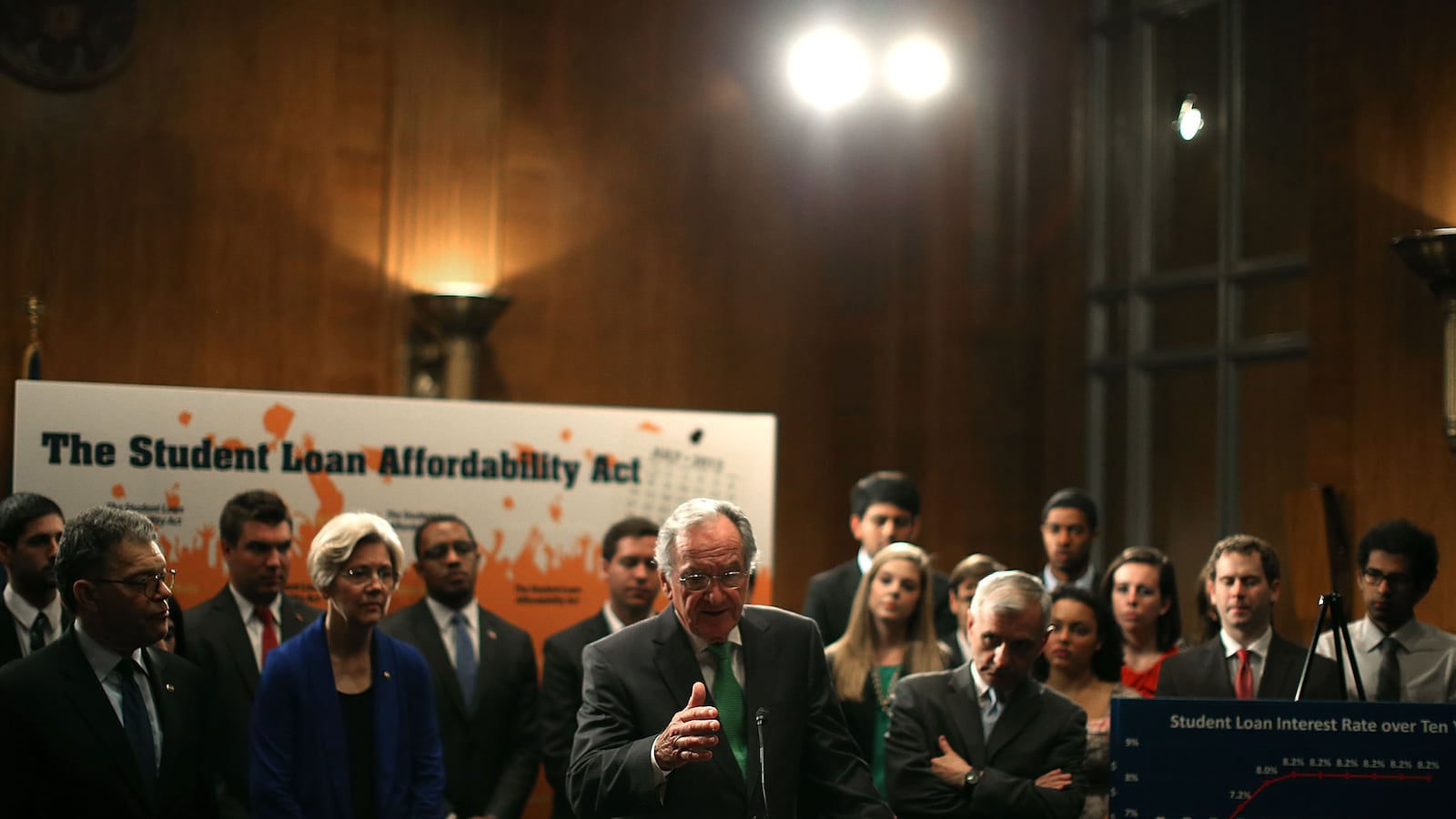Starting Monday, 7 million college students will be forced to pay thousands of dollars more on their loans.
That is, unless Congress passes a bill preventing interest rates on these loans from doubling.
Fat chance.

While you were refreshing SCOTUSBlog or celebrating the death of DOMA, Congress has been trying and failing to prevent interest rates on federal Stafford loans—the most popular form of college funding—from increasing from 3.4 percent to 6.8 percent.
The increase will affect an estimated 7 million students who plan to take or renew loans after July 1. It could force those students to pay as much as $3,834 in additional interest payments over a 10-year period. Congress can still pass retroactive legislation stopping the increase after July 1, but not before causing significant uncertainty for students. The 37 million Americans who are still paying off existing loans won’t be affected.
“Why are we making it more difficult for kids to start their lives by putting them in hundreds of thousands of dollars in debt before they’re 25?” asks Jasmine Flores, who is starting college in the fall and is livid that she’s facing down more burdensome loans even before she moves into her dorm.
Financial-aid experts are troubled by the likely increase and the congressional stalemate, but say that the student loan system in general is confusing for students and administrators and needs to be simplified.
Justin Draeger, president of the National Association of Student Financial Aid Administrators, says the July 1 increase is just one part of a larger problem: a patchwork of rules and interest rates for every kind of loan.
“That’s why we think it’s so important to have a long-term, comprehensive solution as opposed to focusing in on one subset of loans,” he says. “If we don’t get something resolved now, we’re going to lose momentum,” Draeger says, pointing out that Congress’s July 4th and August recesses are just around the corner.
Draeger also emphasized that even students who won’t be affected by Monday’s increase are still borrowing at high interest rates. Eighty percent of students who take out Stafford loans subsidized by the government—the particular subset of borrowers whose rates will change on July 1—also have unsubsidized Stafford loans with interest rates of 6.8 percent. That means it will be next to impossible to avoid the high interest rates that most loans are subject to.
The fight over student loan reform has been mired in a typical Capitol Hill standoff. One chamber has passed legislation, and the other is waging an ideological showdown in hopes that the other side blinks.
But in this debate, the political script has been flipped.
The Republican-controlled House, usually the source of significant partisan gridlock, has passed student loan legislation, but the Democratic-controlled Senate has refused to budge. In fact, Senate Democrats and many left-leaning groups are prepared to let interest rates double rather than follow the House’s solution, which is to let the rates float on the market. While doing nothing would double interest rates, these senators argue, it would still at least leave the rate fixed at 6.8 percent, preventing market fluctuations from pushing it even higher. As Sen. Jack Reed (D-RI) said Thursday, “No deal is better than a bad deal.”
Much like the House legislation, a Senate bill sponsored by Joe Manchin (D-WV) and Richard Burr (R-NC), which has the support of Republicans and some conservative Democrats, would link student loans to financial markets. Under the plan, interest rates on undergraduate Stafford loans for all students would be the current Treasury rate plus 1.85 percent. Manchin-Burr has already received the backing of Senate Minority Leader Mitch McConnell and John Kline (R-MN), the chairman of the House Education & the Workforce Committee.
But most Democrats are less impressed. They see it as providing possible short-term savings at long-term costs. Tom Harkin (D-IA) described the proposal to reporters as “a classic bait-and-switch.” The initial rates are low, he said, “and then they sock it to you.”
Manchin-Burr co-sponsor Lamar Alexander (R-TN) is more optimistic about the bill, telling The Daily Beast Thursday that he thinks there’s an “excellent chance” that the bill will pass after the recess. Alexander is convinced that once his colleagues “see the choices between a short-term political fix that helps 40 percent of the students versus a long-term permanent solution that reduces every loan for 100 percent, I think they’ll come back for the permanent solution.”
Democrats are pushing for a one-year extension on the current interest rates, which were already extended once, in 2012. The Democratic plan, introduced by Reed and Kay Hagan (D-NC) on Thursday, would keep the interest rates at 3.4 percent through 2013 and pay for this by closing a loophole in the tax code to shorten the length of time that tax payments can be deferred on certain inherited IRAs and 401(k)s.
Long-term student loan reform would then be included in the next reauthorization of the Higher Education Act—the current package is due to expire at the end of the year. Democrats hope that then, rather than just focus on rates for future college students, a comprehensive solution could be reached that would address the $1 trillion in student loan debt outstanding.
This would still require passing the one-year extension, though, and those prospects aren’t promising. A two-year extension already failed to receive the 60 votes necessary to avoid a filibuster when it was brought to the floor several weeks ago, and, even if this short-term fix passes the Senate, it is unclear how successful the legislation will be in the House.
In an interview with The Daily Beast, Massachusetts Sen. Elizabeth Warren shuddered at the thought of a rate increase. In her opinion, the program, which generates billions in revenue for the government every year, is already “a tax that’s paid by middle-class kids, working-class kids, bootstrappers that are out there trying to make something of themselves” and badly in need of reform. She added: “Our kids can’t afford Republicans.”
With Congress gridlocked, students across the country are preparing to pay more on their loans, and students with preexisting loans are wondering how much more expensive loans can become.
“Part of my job is to make college an option for my kids,” says Natalia Hokin, a recent college graduate who teaches low-income students in Chicago and is working to pay off her own loans.
“But with the cost of tuition and loans, I know that college is financially impossible for most of them, or it will leave them shackled to private banks for decades,” she says, “and that breaks my heart.”







